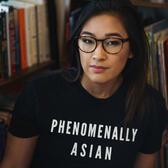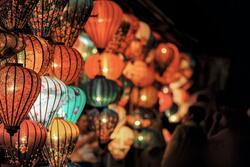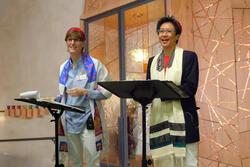Learning Asian Jewish History Helped Me Make Space for Both My Identities
“How are you Jewish?”
Like many Jews of color, I’ve had my share of experiences with white-presenting Jews questioning or doubting my Jewishness. As a child, I fielded comments from classmates, camp bunkmates, even rabbis, who demanded to “see my receipts,” all while struggling to pinpoint who I was as an adopted Asian Jew. This meant that most of my energy was spent playing defense, rather than devoting time and energy to learning about the beautiful ways my identities intersect.
Little did I know that my own history would become my greatest ally.
Growing up, my peers and I learned Jewish history in a vacuum at Hebrew school once a week. In grade school, we learned about the Holocaust in a similarly disconnected way. We were given little context of the history of the Jewish diaspora, let alone the broad and beautiful diversity of Jews around the world. For all I knew, there were two groups of Jews: Ashkenazi (like my adoptive family), and Sephardic, a community I knew little about, except that they could eat rice and lentils during Passover. From my limited perspective, Jewish history and identity were solely tied to communities in Europe.
As I grew up and developed greater self-awareness, I began searching for a community within the Jewish community. I read articles and social media posts about different Asian American Jews, many of whom were also adopted. We seemed to appear like freckles, popping up here and there, always among a sea of pale faces.
In college, I took my first trip back to Korea since my adoption. I did an internet search on synagogues, which proved disappointing. At the time, the only synagogue in Korea was on the US military base. Still, this search opened up a whole new area of curiosity. Had the Jewish diaspora truly never reached beyond Western Asia? Was there nothing I could grasp onto?
What I discovered was the validation of belonging that I had always hoped for. For centuries, not only have there been Jews in Asia, but there has also been a history of Asian-Jewish solidarity. Imagine my surprise when I read my first article about the Jews of Kaifeng, China. Jews from India and Persia first arrived in China during the Song dynasty, and grew to a community of approximately 5,000 people. Kaifeng Jews built their first synagogue in 1163 and worshiped in both Hebrew and Mandarin, praying in the direction of Jerusalem.
I also learned of the Jews of Cochin, the oldest Jewish community in India, as well as the Paradesi Jews and the Jews of Goa. The presence of Jews in India can be traced back to the time of King Solomon. What amazed me most about these Asian Jewish communities is that they experienced relatively little antisemitism compared to their Europeean counterparts, and many Asian communities recognized their commonalities. However, the ease of acclimation was both a blessing and a curse, and led to many Kaifeng Jews assimilating into mainstream Chinese culture. On top of that, the Chinese government’s opposition towards all organized religion contributed to the dwindling of the Jewish community and pushed Jews to practice their religion in secret.
Out of everything I read, nothing stirred me as much as the story of Japanese Imperial Consul Chiune Sugihara, the first Japanese diplomat posted to Lithuania, who saved the lives of thousands of Jews during World War II. At the dawn of the war, Sugihara saw thousands of Jews struggling to flee for safety as Germany invaded Poland. Defying orders from the Japanese government, Sugihara granted visas to Japan for nearly 6,000 Jewish refugees. In 1984, the Israeli Holocaust Museum Yad Vashem awarded him the title of “Righteous Among the Nations.”
For far too long, I tried to reconcile my Jewish and Asian identities into a history and narrative that didn’t seem to have space for them both. It felt like trying to fit a square peg in a round hole. Now I know that my Asianness and Jewishness are intertwined. I cannot separate these parts of who I am from one another, nor do I wish to. I belong. We belong. We always have and we always will.








Thank you for sharing these stories and highlighting that Jews from all cultural backgrounds are not a new thing. They have existed as long as Jews have, but have been written out of the single narrative of "who is a Jew". May this be a seed among many that helps expand the Jewish history we learn in Hebrew Schools and beyond.
This was so beautiful and validating (as another Asian Jew.) I also just learned a bunch of brand new history!